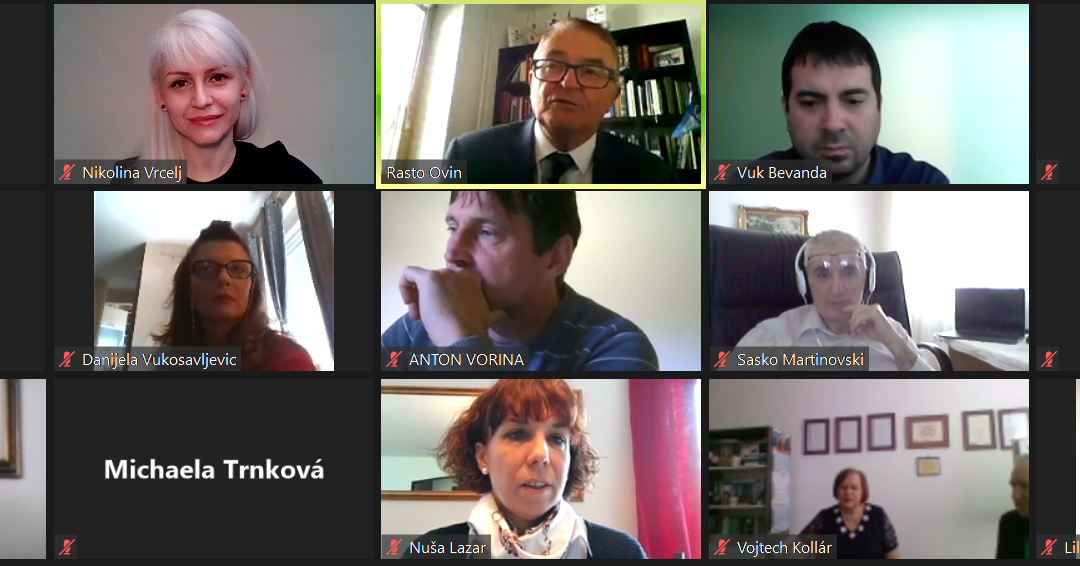Integrating the 21st Century Skills into the Business English Classroom
Tatjana Dugošija – Western Serbia Academy of Applied Studies, Valjevo Department, Vuka Karadžića 3a, 14000 Valjevo, Serbia
Keywords:
Business English;
Employability skills;
Higher education
Abstract: In a globalized world, characterized by the interdependence of the world’s economies, cultures and populations and therefore requiring a shared means of communication, English has obtained the status of the lingua franca in both academic and business contexts and it has been extensively used in scientific, economic and political fields. Consequently, English has become essential for the entire workforce whose career prospects on the labor market are largely dependent on their English language proficiency, the ability to communicate effectively and overcome language and cultural barriers.
Being spoken by over one billion people, English is used in a wide range of settings such as international business, diplomacy, science, technology, education, travel and entertainment. The status of English as an international language and its impact on the improvement of career prospects have resulted in enormous development of English for Specific Purposes (ESP), an approach primarily focusing on developing learners’ communicative competence in specific professional fields such as business and economics, science, medicine, technology, tourism, social studies, etc. Business English (BE), as a branch of ESP, implies teaching specialized vocabulary and different skills enabling learners to effectively communicate in a business environment.
However, major technological and scientific advances in the last few decades and the age of the knowledge-based economy in which we now live have caused society and the business environment to be changing rapidly. As a result, employers are looking for skills that go beyond academic qualifications and work experience, and match the requirements of the current age. These skills, variously labeled and frequently referred to as the 21st-century skills, comprise communication, critical thinking and problem solving, teamwork, creativity and innovation, decision making, digital literacy, leadership, etc.
The aim of this paper is to explore how the 21st-century skills can be integrated and developed in the Business English classroom at tertiary education level since the traditionally taught skills such as giving opinions, negotiating, participating in meetings, reporting, making arrangements, telephoning and socializing in business contexts, no longer seem to meet the requirements of the current age and the contemporary labor market. Business English courses at the university level can significantly contribute to developing these skills and thus prepare students for their future careers.


7th International Scientific ERAZ Conference – ERAZ 2021 – Conference Proceedings: KNOWLEDGE BASED SUSTAINABLE DEVELOPMENT, Online/virtual, May 27, 2021
ERAZ Conference Proceedings published by: Association of Economists and Managers of the Balkans – Belgrade, Serbia
ERAZ conference partners: Faculty of Economics and Business, Mediterranean University, Montenegro; University of National and World Economy – Sofia, Bulgaria; Faculty of Commercial and Business Studies – Celje, Slovenia; AMBIS University, Prague – Czech Republic; Faculty of Applied Management, Economics and Finance – Belgrade, Serbia
ERAZ Conference 2021 Conference Proceedings: ISBN 978-86-80194-46-2, ISSN 2683-5568, DOI: https://doi.org/10.31410/ERAZ.2021
Creative Commons Non Commercial CC BY-NC: This article is distributed under the terms of the Creative Commons Attribution-Non-Commercial 4.0 License (https://creativecommons.org/licenses/by-nc/4.0/) which permits non-commercial use, reproduction and distribution of the work without further permission.
References
Brieger, N. (1997). Teaching Business English Handbook. York: York Associates.
Casner-Lotto, J., & Barrinton, L. (2006). Are They Really Ready to Work? Employers’ Perspectives on the Basic Knowledge and Applied Skills of New Entrants to the 21st Century U.S. Workforce. Washington, DC: Partnership for 21st Century Skills. Retrieved from: https://files.eric. gov/fulltext/ED519465.pdf
Chang, S. Y., & Tung, C. A. (2009). Incorporating 21st Century Skills into Business English Instruction. Feng Chia Journal of Humanities and Social Sciences, 19, 255-286.
Dudley-Evans, T., & St John, M. (1998). Developments in English for Specific Purposes: A Multi-Disciplinary Approach. Cambridge: Cambridge University Press.
Ellis, M., & Johnson, C. (1994). Teaching Business English. Oxford: Oxford University Press.
Fettes, T. (2018). Putting Skills to Work: Final report of a study funded by CET. London: Commercial Education Trust. Retrieved from: https://thecet.org/wp-content/uploads/ /2018/10/ Putting-Skills-to-Work-June-2018.pdf
Hutchinson, T., & Waters, A. (1987). English for Specific Purposes: A learning-centred approach. Cambridge: Cambridge University Press.
Larsen-Freeman, D. (2000). Techniques and Principles in Language Teaching (2nd ed.). Oxford: Oxford University Press
Lemke, C. (2002). EnGauge 21st Century Skills: Digital Literacies for a Digital Age. Washington, DC: Office of Educational Research and Improvement.
Lemke, C. (2003). EnGauge 21st Century Skills: Literacy in the Digital Age. Naperville, ILL: North Central Regional Educational Laboratory/Metiri Group.
Mann, A., Kashefpakdel, E. T., Rehill, J., & Huddleston, P. (2017). Contemporary transitions: Young Britons reflect on life after secondary school and college. Occasional Research Paper 11. London: Education and Employers Research. Retrieved from: https://www. educationandemployers.org/wpcontent/uploads/2017/01/Contemporary-Transitions-30 -01-2017.pdf
Mercer, S., Hockly, N., Stobart, G., & Galés, N. (2019). Creating Empowered 21st Century Citizens: Oxford: Oxford University Press.
Muslim, A., Kurniawan, E., Purnawarman, P., Danuwijaya, A. A., Novianti, N., Zifana, M., & Hakim, L. (Eds.). (2017). Proceedings of the Ninth International Conference on Applied Linguistics (CONAPLIN 9). Atlantis Press. Retrieved from: https://www.atlantis-press.com/proceedings/conaplin-16/25874124
Nunan, D. (1989). Designing Tasks for the Communicative Classroom. Cambridge: Cambridge University Press.
Organization for Economic Co-operation and Development. (2018). The Future of Education and Skills: Education 2030. Paris: OECD. Retrieved from: https://www.oecd.org/ education/2030/ E2030%20Position%20Paper%20(05.04.2018).pdf
Paltridge, B., & Starfield, S. (Eds.). (2013). The Handbook of English for Specific Purposes. Chichester: Wiley-Blackwell.
Richards, J. C. (2006). Communicative Language Teaching Today. Cambridge: Cambridge University Press.
Strapasson, G. (2015). Needs analysis and English for business purposes [Master’s thesis, Universidade Technologica Federal do Parana]. Instituto Brasileiro de Informação Em Ciência e Tecnologia. Retrieved from: http://repositorio.roca.utfpr.edu.br/jspui/bitstream/1/6711/1/CT_COLET_2015_1_03.pdf
The British Chambers of Commerce. (2014). Workforce Survey 2014. London: BCC. Retrieved from: https://www.cambridgeshirechamber.co.uk/downloadlibrary/BCCWorkforceSurvey.pdf
The Partnership for 21st Century Learning. (2015). P21 Framework Definitions. Washington, DC: The Partnership for 21st Century Learning. Retrieved f rom: http://static.battelle forkids.org/ documents/p21/P21_Framework_Definitions_New_Logo_2015_9pgs.pdf
The Partnership for 21st Century Learning. (2016). Framework for 21st Century Learning. Washington, DC: The Partnership for 21st Century Learning. Retrieved from: http://static.battelleforkids.org/documents/p21/P21_framework_0816_2pgs.pdf
Thomas, J. W. (2000). A Review of Research on Project-Based Learning. San Rafael, CA: Autodesk Foundation.
Trilling, B., & Fadel, C. (2009). 21st Century Skills: Learning for Life in Our Times. San Francisco, CA: Jossey-Bass/Wiley.
Varis, T. (2007). New technologies and innovation in higher education and regional development. Revista de Universidad y Sociedad del Conocimiento, 4(11), 16-24.
Willis, J. (1996). A Framework for Task-Based Learning. Harlow: Longman.
World Economic Forum. (2016). The Future of Jobs: Employment Skills and Workforce Strategy for the Fourth Industrial Revolution. WEF. Retrieved from: http://www3.we forum.org/docs/ WEF_Future_of_Jobs.pdf
Yildiz, Y. (2020). Task-Based Language Teaching: An Approach in the Spotlight to Propel Language Learning Forward. International Journal of Social Sciences & Educational Studies, 7(1), 72-77.

